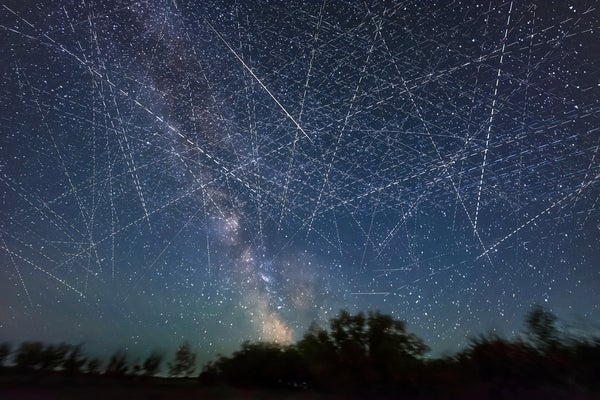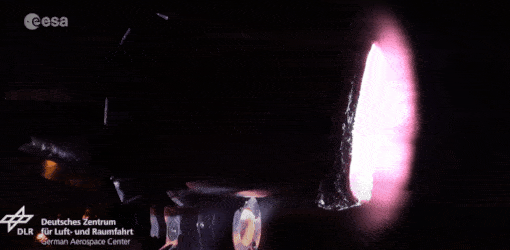Satellite Mega Constellations Could Jeopardize Ozone-Hole Recovery
Pollution from skyrocketing numbers of satellites burning up in Earth’s atmosphere could threaten our planet’s protective ozone layer

Light trails from satellites in low-Earth orbit fill the sky in this composite long-exposure photograph, which was captured over a 30-minute period.
Alan Dyer/VWPics/Alamy Stock Photo
From the ground, Earth’s sky seems boundless and everlasting, but the view from above shows something different—a perilously thin blue line against the black void, all that stands between our living world and the lethal conditions of space. It’s in this fragile expanse that scientists are now recognizing a long-present danger: pollution from reentering satellites and other orbital debris. According to a new study, this emerging threat could compromise the delicate balance of our planet’s protective ozone layer.
Without costly regular reboosting, all satellites in low-Earth orbit are destined for a fiery fate—to gradually lose altitude until they burn up and disintegrate against the thin outer layers of the atmosphere. Since the dawn of the space age, this process has been taken for granted as an easy and consequence-free way of taking out Earth’s orbital trash. Now, however, a new study inspired by skyrocketing numbers of satellite reentries estimates that airborne aluminum oxide pollution from satellites has increased eightfold between 2016 and 2022. More alarmingly, the research suggests this accumulating debris can damage our protective atmospheric ozone shell. “We shouldn’t jump to conclusions right away,” says José Ferreira, lead author of the study and a researcher at the University of Southern California, “but the numbers are very concerning.” The study appears in a June edition of Geophysical Research Letters.
Earth’s Broken Shield
On supporting science journalism
If you’re enjoying this article, consider supporting our award-winning journalism by subscribing. By purchasing a subscription you are helping to ensure the future of impactful stories about the discoveries and ideas shaping our world today.
Ozone, a highly reactive compound comprised of three oxygen atoms, forms one of the most critical components of Earth’s atmosphere. Tight bonds hold the molecule’s oxygen atoms together, allowing a layer of ozone in the stratosphere to absorb most of the harmful ultraviolet (UV) radiation streaming in from space, preventing it from reaching Earth’s surface. Ozone is also susceptible to degradation by human activities, however. In the 1970s scientists discovered that chlorofluorocarbons (CFCs) from household products were eating a “hole” in the ozone layer, profoundly weakening its protective effects.
Although ongoing efforts to repair the ozone hole have shown remarkable success, a new set of pollutants could reverse that recovery. In a study published last October, scientists discovered unusually high amounts of vaporized metals such as aluminum, copper and lithium accumulating in the stratosphere—an anomaly attributed to rocket launches and the reentry of satellites. “We know that satellites reenter the atmosphere, heat up, vaporize—[and] somehow these metals get into the stratosphere,” says Martin Ross, an author on that study and an atmospheric scientist and senior project engineer for the Aerospace Corporation. He adds that a more comprehensive understanding of the potential extent of pollution—from vaporizing to settling in the stratosphere—is needed.

A timelapse view of a bulky satellite component melting and disintegrating during a test in a plasma wind tunnel.
Surging numbers of satellites seem set to only exacerbate the spiking levels of stratospheric metals. More than 8,000 already reside in low-Earth orbit, and tens of thousands more are planned, mostly in the form of so-called mega constellations, such as SpaceX’s Starlink, a system of satellites that provides global broadband Internet access. Starlink and other mega constellations rely on an economy of scale; their massive fleet is continually refreshed with new satellites to replace old ones that burn up in Earth’s atmosphere. The result is a drastic increase in rocket launches and spacecraft reentries. “There’s this widespread assumption that something burning up in the atmosphere disappears, but, of course, mass never disappears,” says Michael Byers, Canada research chair in global politics and international law and co-director of the Outer Space Institute.
Inspired by last year’s striking detection of metals in the stratosphere, Ferreira and his colleagues examined the extent to which each satellite can contribute metallic pollutants. Their study simulated interactions between an incoming satellite and oxygen atoms in the mesosphere, or middle layer of the atmosphere, which lies above the stratosphere. The work found that the plunging satellite’s flash-heated aluminum would rapidly erode to react with oxygen and form aluminum oxide. This, it turns out, may be very bad news for stratospheric ozone.
In sufficient concentrations, aluminum oxide easily catalyzes ozone’s destructive reaction with chlorine gas, which splits the ozone molecule and diminishes Earth’s UV shield. Furthermore, because aluminum oxide is left intact by this process, it can continue reacting with ozone. The compound’s persistence means that even small quantities have the potential to cause significant long-term impacts on the ozone layer. Scaling their result up to current mega constellations and publicly known plans for future expansions, Ferreira and his co-authors estimate that in 2022 alone, satellites pumped 17 metric tons of aluminum oxide into Earth’s mesosphere. Chillingly, that influx would rise to some 360 metric tons of aluminum oxide per year if the rapid planned proliferation of mega constellations continues. The study also modeled aluminum oxide’s atmospheric dynamics, showing the particles could take up to 30 years to drift down to the stratosphere to wreak havoc on the ozone layer. “While [the pollutant] accumulates in the atmosphere, it’s time that we are losing. By the time we see the results, it may be too late,” Ferreira says.
Defensive Measures
Understanding how infalling space debris attacks the ozone layer is only part of the battle. Should independent studies validate these findings, the next critical challenge will be developing tactics to counteract these effects.
The discovery of the ozone hole in the 1970s led to the following decade’s Montreal Protocol, an international treaty that spurred global leaders to successfully combat the CFC problem in the 1980s. But applied to pollution from reentering satellites rather than from refrigerators and cans of hairspray, this sort of international treaty seems less like a model for solutions and more like a damning indictment of gaps in our current regulatory frameworks. The Montreal Protocol showed that with global coordination, complex environmental issues can be managed. Existing rules and restrictions for orbital activity, however, appear to offer poor, conflicted prospects for any easy solution. For example, the Federal Communications Commission mandates that U.S. satellites in low-Earth orbit must be deorbited within five years of mission completion. These regulations primarily aim to prevent orbital overcrowding, but they fail to consider potential atmospheric impacts. “It’s an interesting paradox,” Ferreira says. “We need to clear the orbital environment, but we don’t know what the cost is to the atmosphere.”
Brian Weeden, systems director at the Center for Space Policy and Strategy at the Aerospace Corporation, adds, “The current regulatory framework wasn’t built for this kind of thing. There’s no checkbox that says, ‘Also, take a look at whether or not this has an impact on the upper atmosphere,’ because this wasn’t an issue anyone was thinking about.” Yet satellite launches continue, and as we slowly learn more about the process, “it keeps becoming a bigger issue,” Ross says. “We’re blind but keep driving down the road.”
Ferreira and his colleagues’ work exposes the mounting invisible space pollutants threatening our protective atmosphere. But predicting atmospheric dynamics is one problem, and predicting the global response is potentially an even greater one. “I’m hopeful that this time we can be faster and more clever than when you look at climate change, for example,” adds Leonard Schulz, a researcher at the Technical University of Braunschweig’s Institute of Geophysics and Extraterrestrial Physics in Germany. “We can act fast on [this issue], and we have to work together.”
